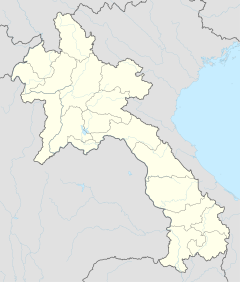Tam Pa Ling Cave

South entrance to the cave
|
|
|
location in Laos
|
|
| Alternate name | Cave of the Monkeys |
|---|---|
| Location | Houaphanh Province, northern Laos 260 km (160 mi) NNE of Vientiane |
| Region | Annamite Mountains |
| Coordinates | 20°12′31″N 103°24′35″E / 20.20861°N 103.40972°ECoordinates: 20°12′31″N 103°24′35″E / 20.20861°N 103.40972°E |
| Type | Cave |
| Part of | Pa Hang Mountain |
| Length | 40 m (130 ft) |
| Width | 30 m (98 ft) |
| History | |
| Material | limestone, karst |
| Periods | Upper Paleolithic, Middle Paleolithic |
| Associated with | Paleo-humans |
| Site notes | |
| Excavation dates | 2008 |
| Archaeologists | Fabrice Demeter, Laura Shackleford |
Tam Pa Ling (Cave of the Monkeys) is a cave in the Annamite Mountains in north-eastern Laos. It is situated at the top of Pa Hang Mountain, 1,170 m (3,840 ft) above sea level.
Two hominin fossils have been discovered in the cave: 'TPL1', a skull belonging to an anatomically modern human; and 'TPL2', a mandible with both modern and archaic traits. The fossils represent two separate individuals and are between 46,000 and 63,000 years old. The discoveries definitively established that modern humans had migrated to Southeast Asia by at least 60,000 BP.
Tam Pa Ling has a single, south-facing opening and descends 65 m (213 ft) to its main gallery. It is part of a network of karst caves, formed by the dissolution of limestone beds that were laid down between the Upper Carboniferous and Permian periods. The main gallery measures 30 m (98 ft) from north to south and 40 m (130 ft) from east to west.
Excavations at the eastern end of the cave's main gallery, at the base of the sloped entrance, were conducted by a team of American, French and Laotian researchers starting in 2009.
The first fossil find, a hominin skull dubbed 'TPL1', was recovered at a depth of 2.35 m (7 ft 9 in) in December 2009. A mandible, 'TPL2', was found the following year at a depth of 2.65 m (8 ft 8 in). Radiocarbon and luminescence dating of the sediments established a minimum age of 51,000 to 46,000 years, and direct uranium-thorium dating of the fossils indicated a maximum age of 63,000 years.
TPL1 includes the frontal, partial occipital, right parietal, and temporal bone, as well as the right and left maxillae and a largely complete dentition. It was identified as belonging to an anatomically modern human with distinct Sub-Saharan African features. As of 2016[update], it provides the earliest skeletal evidence for the presence of Homo sapiens in mainland Southeast Asia.
...
Wikipedia

